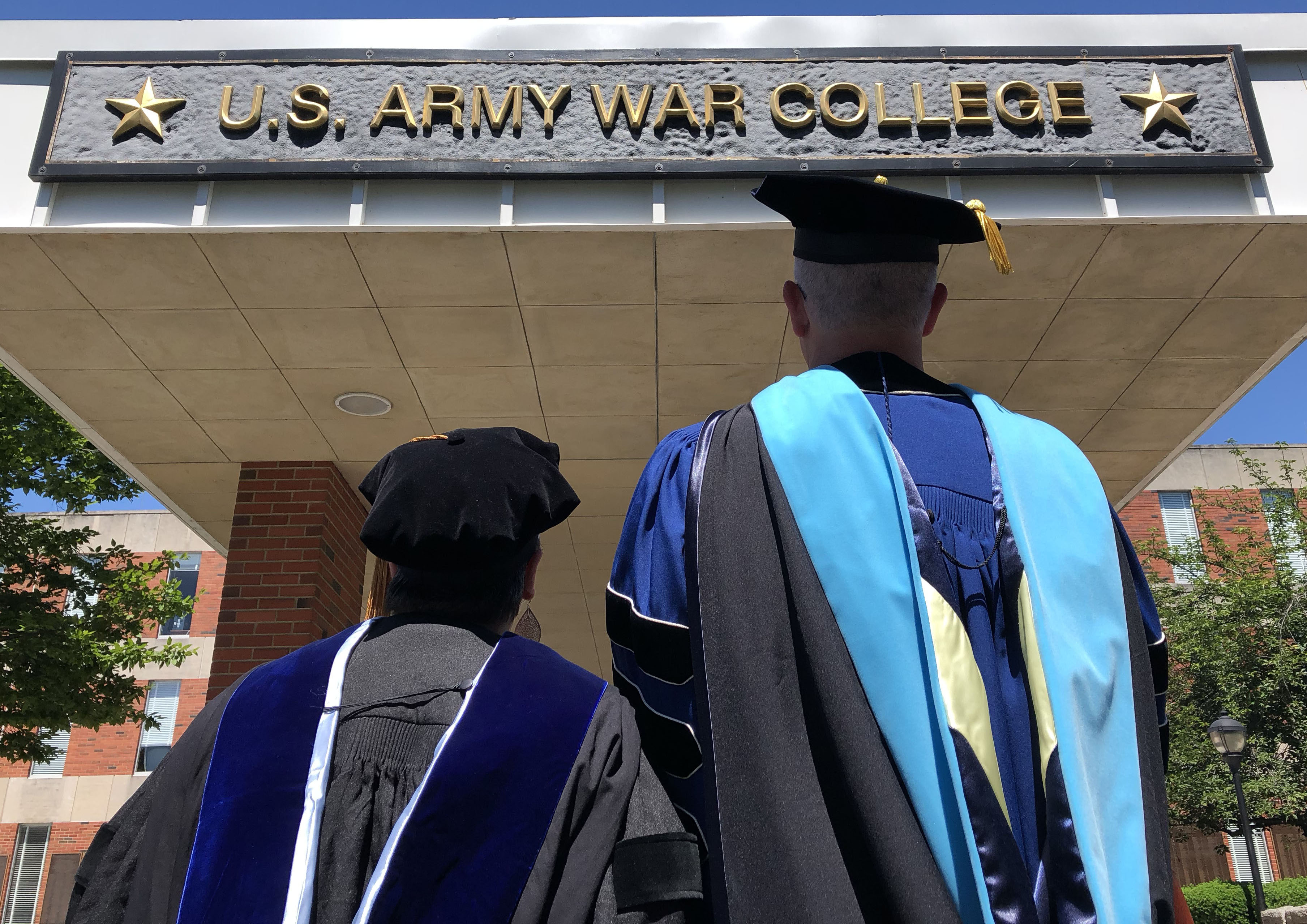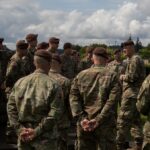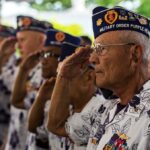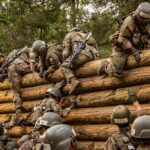
Army leadership should inject more ‘college’ in the War College by hiring more civilian academic instructors.
When I arrived at the U.S. Army War College in August 2017 as the Harold K. Johnson Chair in Military History I walked into an institution debating its future. During my first weeks at the War College, I met with the leaders of the institutions with which my position was associated – the provost and the director of the Army Heritage and Education Center, which houses the Army’s historical archives. Within minutes of beginning the discussions, each asked whether I thought that the War College should employ more civilian instructors. Of course, I counted as a civilian instructor myself – sort of. I constituted one of the 30 to 40 civilians brought in on one-to-two-year contracts, ranging from endowed chairs like mine to what in the civilian world we would call non-tenured faculty – lecturers, part time instructors, adjuncts. I was a civilian who had come to spend a year with the U.S. Army, hoping to learn what I could about bridging the so-called civilian-military gap.
The existence of that gap lay at the core of the faculty composition question. The U.S. Army War College operates as a senior Professional Military Education (PME) institution alongside the Air War College, the Naval War College, the Marine Corps War College and National Defense University. The Army War College’s mission is dual, encapsulated by the name itself – “war” and “college”. On the one hand, as a military institution, it must train senior leaders before they take command at the brigade level or take on complex new staff positions. On the other hand, as an institution of higher education, it must provide intellectually challenging curriculum and instruction to produce educated, informed, critically-minded senior leaders. Over the course of my year at the institution, I came to understand the question that the college’s leadership asked as reducible, at some level, to which side of the college’s mission needed more emphasis: more “war” or more “college”?
Of course, such a broad question raises far more issues than the civilian versus military composition of the faculty. I came to understand that everything from the course list to the organization of students into classes, and from the nature of written assignments to the extracurricular expectations, all reflected the dual mission of the institution. But the faculty composition is perhaps the most obvious and relevant measure to gauge how the institution is answering that question, given the central role faculty members play in determining the other aspects of education at the institution.
When I arrived at the War College, I did not yet know the statistics of civilian versus military instructors, but the view on the first day when uniforms were required (the War College has dress codes) immediately made clear the large numbers of active duty military faculty. Even many of the instructors not wearing uniforms, however, looked as though they had only recently mothballed them – military haircuts, a military style of “casual dress,” military bearing, and of course military jargon abounded in the hallways and classrooms. Even without the statistics, it was obvious how military personnel and retired military personnel guided the institution.
But the numbers got my attention nevertheless. The current faculty in the residential program at the War College is overwhelmingly active duty or retired military officers. Exactly half of the full-time, budgeted faculty are current military personnel (47 of 91). There are 44 full-time, budgeted civilian “Title 10” faculty members. Of those 44 civilians, however, 55 percent, or 24 people, are former military personnel. So of the total 91 full-time budgeted faculty in the residential program at the War College, 71 are military personnel or retired military personnel, comprising 76 percent of the total budgeted full-time faculty. By this measure, the faculty is over three times as much “war” as it is “college.” Military and former military personnel sit in the most important academic offices, too, where all but one person in designated “civilian” leadership roles at the War College — from the provost to his deputy to the dean, to the directors and the department heads – are retired military officers.[1]
Some might object that I count former military personnel as “military” faculty, as they technically are no longer military personnel. While I recognize the nominal validity of this argument, I reject its substance. As Erving Goffman pointed out decades ago, military personnel lead an “enclosed formally administered round of life,” and removing the uniform does not remove the effects of this life. Indeed, retired military members of the faculty are not seen as equivalent to “pure” civilians by the War College itself. They are often hired precisely because they differ from civilians: they have familiarity with the military, “know” what colonels do, and understand how to operate within the military’s bureaucracy. Even as they are categorized technically as “civilians”, their military insider status is often claimed as a special asset. The not uncommon practice of hiring instructors directly from their military billet into a civilian billet demonstrates how military personnel remain “military personnel” even when they remove their uniforms.
Career PME faculty members, like Joan Johnson-Freese, have weighed in on the balance of military versus civilian academic influence, and I do not have the in-depth knowledge and experience they do. But even my one year of experience in teaching, researching, and observing at the War College offered a clear answer to the question posed to me by senior leaders at the school: Army leadership should inject more “college” in the War College by hiring more civilian academic instructors.
Outsiders who have different assumptions about the military Are more likely to question received wisdom about military and national strategy, defense management, and even operations planning.
Civilian academics without military service background can strengthen the mission of the War College in five ways.
1. Employ More Civilian Academics
Employing more full-time, permanent civilian academic instructors will foster connections between civilian society and the military that are essential to healthy democracy and to a well-regulated professional military. Employing more civilian professors brings more people like me – people who know the military only from research – into direct contact with military personnel. This contact allows us to understand the tasks military personnel undertake. A great deal of research documents the military-civilian gap, and many commentators from the military side have bemoaned this separation. Being a civilian at the War College has increased my sense of understanding and ownership of the military, which, after all, is a vital public institution – and one specifically subject to civilian control.
2. Ensure Broad Representation of Academic Fields
Civilians are likely to have broader and more critical views of the military. By “critical”, I do not mean necessarily leveling criticism, though that can be valuable, but taking a holistic, questioning, evidence-based stance toward the military and national security. Coming into classes with an outside perspective is invaluable in an institution that sociologists recognize as a “total institution,” one that, unlike most civilian employment, envelops nearly every aspect of life. Senior military leaders who have grown up in the total institution of the military could hardly fail to have a critical perspective on it; but their critical perspectives are those of insiders, and of personal experience. Outsiders who have different assumptions about the military are more likely to question received wisdom about military and national strategy, defense management, and even operations planning. And civilians—outsiders—can bring civilian institutional experience and evidence-based inquiry to bear on both management and instruction.
3. Reduce the Military Jargon
Civilian instructors provide opportunities for students to interact with the kinds of expert civilians with whom students will work when they assume their next assignments. Students leaving War College take on larger and more complex leadership roles that require cooperation with civilians, many of whom are highly educated and experienced in their respective fields. Military leaders need commensurate educations with civilian counterparts in other federal agencies, in Congress, and in the private sector. Knowing how to speak beyond military jargon, and how to understand their institution from the perspectives of leaders in international relations or systems management are vital to leading the military. Civilian instructors provide such experiences, and their presence in the classrooms will better situate military leaders for post-graduate leadership.
4. Emphasize Diversity and Inclusion
Civilian instructors offer a way to bring much-needed diversity to the War College. The heavy reliance on current and former officers as instructors at the War College produces an over-representation of white male instructors. Of the overall full-time budgeted faculty members, only 8.5 percent are women and only 8 percent are non-white. These percentages are starkly out of line with the demographics of civilian higher education institutions. One third of Big Ten university faculty members are women. Many business schools, especially those ranked in the top 40, employ between 20-28 percent women faculty. The percentage of faculty of color at the War College is lower, but more in line with this measure in civilian academia, where percentages hover around 11 percent in the Big Ten. Notably, the small number of women and people of color on the full-time budgeted faculty at the War College is also out of line with the composition of the officer corps of the U.S. Army itself, where around 18 percent of active duty officers are women and 27 percent of active duty officers are nonwhite. The lack of diversity suggests that instructors are drawn from too small a pool of applicants, thus leaving out of the classroom many potentially highly qualified candidates. The number of women who hold PhDs has grown enormously in fields essential to the War College curriculum such as political science, history, regional studies, and organizational behavior. Numbers of African American PhDs are growing, too, with over 20 percent of history PhDs awarded to African Americans. In addition to enlarging the pool of excellent instructors, using civilian hires to achieve greater faculty diversity will produce positive outcomes for student learning and achievement. Research now shows definitively the instructional strength of diversity in the classroom.
5. Encourage More Traditional Research
Civilian academic instructors are more likely to be active researchers, and to bring that vanguard knowledge into the institution. This is really the nub of the more “war” or more “college” Only 10 percent of the active duty military faculty members at the War College hold a PhD or a JD. Of the former military service civilians, only 41 percent hold PhDs. By contrast, purely civilian instructors with no military experience have by far the highest educational levels – fully 85 percent of them hold doctorates. At the War College, these pure civilian scholars on average have written more articles and books, delivered more conference papers, and participated to a greater degree in the development of their fields and subfields than military faculty or former military faculty. Other graduate professional schools like business schools which, like the War College, must offer some clinical training, would never dare to operate with as few PhD professors as the War College. Between three quarters to four fifths or more of faculty members at most of the top 40 business schools, from Stanford to Notre Dame to University of Pittsburgh, hold PhDs. The reason is that career academics pursuing cutting-edge research – whether in management and finance, political science, area studies, history, strategic studies, or psychology – bring the most current empirical studies and theory into the classroom. Depriving War College students of civilian academic faculty is thus likely to deprive them of the best available knowledge in the academic fields central to the War College curriculum.
The War College is hardly the only institution of higher education engaged in self-reflection at the moment. For civilian colleges and universities, high costs, declining funding, and changing job markets have made it necessary to think deeply about their roles in today’s society. Some of the questions civilian institutions face about what is an appropriate education, and how best to deliver it are similar. But the questions facing PME institutions are also unique to the military – how best to prepare leaders in a vast institution charged with executing state violence and maintaining defense, and how best to foster a healthy relationship of this institution to civilian society? Both the questions shared with civilian institutions and those specific to the military may be better addressed by a commitment to hiring more civilian academic full-time budgeted faculty members at the War College.
[1] All USAWC faculty information obtained by the author, courtesy of the Office of the Provost.
Jen Mittelstadt is the Harold K. Johnson Chair of Military History at the U.S. Army War College. The views expressed in this article are those of the author and do not necessarily represent those of the U.S. Army War College, U.S. Army, or Department of Defense.
Photo Credit: U.S. Army War College photo by Genny Hobson.





I think the National Defense University in DC is a closer representation to what you’re envisioning war college to aspire to. With its “whole of government” approach to national security strategy and the sheer number of interagency civilian that also attend you get a more collegiate Socratic approach to the national security domain. That strategic level dialogue is the point and purpose of the war colleges which is to develop strategic leaders to guide our military.
Hello Professor Mittelstadt,
You make several excellent points about needing more diversity within the Army War College faculty. Adding more women and professors of color is certainly a worthy and needed goal. Your article, seems to overlook an important aspect of the U.S. Military; however, which may well be an additional area of needed faculty diversity and also provide a possible solution to the principal problems you describe. Within the category of “retired military officers,” the war college does have representation from branches outside of the Army, namely Navy, Air Force, Marine Corps, and Coast Guard. Within the category of Army retirees, the college could meet several of your stated objectives by hiring more retired Army reservists and retired members of the Army Reserve and Army National Guard (as well as from the Air National Guard, Air Force Reserve, Marine Corps Reserve, Naval Reserve, or Coast Guard Reserve). The college could even hire women and minorities from the Reserve and Guard populations. According to a 2016 Military One Source report on military demographics, the U.S. military has a total population of more than 3.5 million. The combined DoD and DHS Ready Reserve numbers 1,085,109 members. This number is slightly smaller than the DoD Active Duty total of 1,288,596. (The Retired Reserve adds another 200,000 and DoD hires almost 900,000 civilians.) Some of those Reservists, Retirees, and Civilians certainly represent diverse academic fields and conduct research beyond the traditional Clausewitzian trinity.
One of the amazing facets of the Reserve Components from all five branches of the military is the dual hatted nature of the Reserve. Most retired and career Reservists hold down a civilian job or attend school or both, as well as performing a part-time military function; some Reservists also work as adjunct professors. The goal of speaking “beyond military jargon” is an integral part of the monthly and annual routine for the Reservist. Since 9-11, the Reserve Component prides itself in being an Operational Reserve, but as recruiting posters often highlight, Reservists typically wear civilian attire five days a week and then don the uniform for “drill weekends” as well as for long and short active duty stints. The percentages of retired Reservists on the faculty are probably lower than the numbers for women or professors of color, but the pool of potential applicants is incredibly large. The distance learning programs at the various war colleges far exceed the numbers of the fortunate few who get to participate in yearlong residency programs. Hiring more professors from the vast populations of women, non-white, and non-active duty military would add diversity, enhance the acclimation process, and provide a better demographic reflection of the U.S. Military and the U.S. population.
Affirmative Action programs gained momentum in the second half of the 20th century but lost political favor after the 2003 Gratz v. Bollinger decision against gender and minority quotas. Clearly a Proactive Faculty Composition program at the Army War College would help to achieve the five points you raise. Recasting the faculty could reconstitute glass ceilings while mitigating stigmas and stereotypes in the “halls of the sleeping colonels” with the help of struggling middle class advocates getting a foothold at the Carlisle campus.
Well stated, Michael, and your thoughts about the AWC Department of Distance Education (DDE) echoed precisely what I was thinking as I read Professor Mittelstadt’s article. We who are 2-year DDE students bring a diversity of life experience that could not possibly be mirrored by our full-time resident peers and I do believe that our DDE faculty is cut from the same cloth as we are.
I would also add that the entirety of the AWC faculty–both resident and DDE–would benefit tremendously from adding experienced inter-agency professionals from the Department of State, Department of Homeland Security, and even the Department of the Treasury. The majority of my fellow students–present company included–come to AWC with 20-25 years of experience in the security environment. We know very well the “M” in the DIME acronym for instruments of national power. We are expected to think strategically beyond the “M,” though, and it would be helpful if we had faculty who come from such backgrounds.
War College is a single term, not two (or it once was). The original mission “to study and confer on the great problems of national defense, of military science, and of responsible command” has been replaced by, “a curriculum evolved to focus on the strategic level of war. The college transformed from a military school preparing officers to work on the Army staff to a graduate-level college, accredited to award a master’s degree in strategic studies to students.” A few years ago, Thomas Ricks observed that, “Overall, the biggest hole, I would say, is a long-term tendency to study foreign strategic problems, but not to examine battles or wars that did not involve American forces.” Rarely does a day go by in the press wondering why we are still fighting the war in Afghanistan (and elsewhere), especially with far more commanders than there were in Vietnam.
Quibbling about the composition of the institution doesn’t really buttress the argument for more civilians, in fact when “Reducing the Military Jargon” is one of the points that should be lessened, it becomes downright laughable. We’ve also had far too many years of emphasis on “Diversity and Inclusion” based on percentages and bean counting. The Army’s record since Truman is laudable. One has to ask, given the reports emanating from colleges, are creating Safes Zones, coloring and hugging puppies in the War College next?
In general, the Army has pushed education for many years, especially since Vietnam. There are many officers who have also taught college classes themselves, perhaps more can find their way to the War College (this includes enlisted and former enlisted – now there’s a group, often with advanced degrees themselves, who are excluded). Having war experience is obviously a major plus, regardless.
There is no such thing as sort of military because someone watched the Army (?) for a year. One couldn’t possibly understand what it is like, let alone understanding what it’s like being shot at. Because war is fought on battlefields far away, the War College should be run and taught by those who have heard the distant roar of cannon.
Frankly, this is an article long on opinion and short on fact, providing possible solutions to a unproven problem.
Show that the Army War College isn’t meeting its mission (The US Army War College educates and develops leaders for service at the strategic level while advancing knowledge in the global application of landpower)–then your argument may be taken seriously. From a critical perspective, this article is little more than self-serving, PC tripe.
“Show that the Army War College isn’t meeting its mission (The US Army War College educates and develops leaders for service at the strategic level while advancing knowledge in the global application of landpower)–”
Seriously, is that even in *question*? It’s completely obvious to every civilian who’s studied geopolitics that the Army War College isn’t meeting its mission. The US has lost every war it’s gotten into since Truman left office, with the arguable exception of Kosovo, and has never successfully deployed military landpower in my lifetime. Based on this record, the Army War College needs to be completely replaced.
Army leadership is garbage, and we all know it. Maybe fixing the War College, so that future Army leaders actually know some history and geopolitics, would help. General Sherman had a broad, wide-ranging education which gave him the deep insights into economics and culture which he needed to win the Civil War. You won’t get that from today’s overly-narrow War College.
I was stunned to read this article. What is the purpose of the War College? I thought it was to train officers to lead in the military, specifically the US Army. If so, what do diversity and inclusiveness do to accomplish that goal? The purpose of the military is to break things and kill people. We want our officers to excel at that, first and foremost. And we want them to do that while suffering the least number of casualties possible. To do that they need to understand war, not intellectualism or the pursuit of knowledge outside the area of their responsibility.
Has a single brilliant military strategist or tactician ever emerged from the civilian ranks? We learn about war from those who have fought it and learned the hard lessons that are paid for in blood. The best people to teach those lessons are those who have been forged in the fire and suffered the combat losses that taught them what works and what doesn’t.
If we want our military leadership to have a well-rounded education, we should send them to places like Harvard, Stanford and Wharton School of Business. Unless I’m mistaken, we already do that. Let the War College fulfill its purpose without diluting the education of our warrior leadership with unrelated pedagogy.
Interesting to see thoughts from the US regarding a similar debate going on in the UK about the study of military theory and who has the ‘right’ to comment.
An interesting piece from the Wavell Room: https://wavellroom.com/2018/06/21/whose-voice-matters-the-british-army-in-2018/